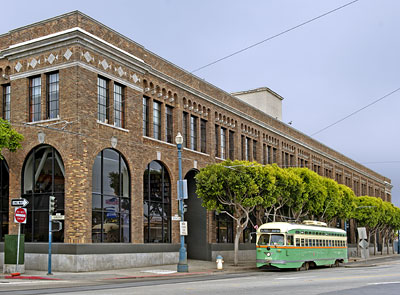National Register of Historic Places in San Francisco
Otis Elevator Company
1 Beach Street At The Embarcadero
Built 1924
Historians of American architecture have long considered the development of the skyscraper as one of the most important aspects of their study. The technologies that permitted such development are usually given as the steel frame, reinforced concrete, the telephone and typewriter, electric light, and the passenger elevator.
Elevator technology improved along with other skyscraper components. Otis introduced the water hydraulic elevator in 1878, the electric elevator in 1889, and the gearless traction elevator in 1903. In 1915 it added a self-leveling device that allowed the elevator to stop exactly at floor level. In 1924 the "Signal Control System" made stops and speed automatic.
The Otis Elevator Company building was built in 1923-1924, to designs by the company's architectural office in Yonkers. The building was used for elevator assembly and the manufacture of the selector mechanism of Otis's Signal Control System. A railroad spur led into the Grant Avenue side of the building. With smaller buildings of similar design in Los Angeles and Portland, the San Francisco office serviced the entire west coast plus Nevada, Arizona, Alaska and Hawaii.
During the Great Depression, when construction activity halted, the San Francisco office was made exclusively a service and maintenance facility.
Otis remained in the building into 1969. After that an intermediary floor was added, and the industrial interior was converted into typical modern offices.
Excerpted from the NRHP nomination dated 2 September 1999.

About twenty of the taller 1920s skyscrapers, usually with setback towers and often with Art Deco styling, exist in San Francisco. Of these, the original elevator contractors are known for only nine, eight of them Otis. The twenty elevators in the 1927 Russ Building were reported by Otis's local manager to "form the largest office building elevator installation on the Pacific Coast."
In the 1920s and 1930s elevators from this Otis plant were installed in most of San Francisco's outstanding new skyscrapers by some of the city's best architects, including:
- Pacific Telephone & Telegraph, 134-140 New Montgomery, 27 stories, Miller & Pflueger, 1924
- Mark Hopkins Hotel, 999 California, 19 stories, Weeks & Day, 1925
- Brocklebank Apartments, 1000 Mason, 10 stories, Weeks & Day, 1926
- Hunter-Dulin Building, 111 Sutter, 25 stories, Schultze & Weaver, 1926
- Russ Building, 235 Montgomery, 31 stories, George Kelham, 1927
- Shell Building, 100 Bush, 29 stories, George Kelham, 1929
- Medical-Dental Building, 450 Sutter, 26 stories, Miller & Pflueger, 1929
- Mills Building Tower, 220 Bush, 20 stories, Lewis Hobart, 1931
- Lurie Building, 417 Montgomery, 10 stories, Wilber D. Peugh, 1936
Excerpted from the NRHP nomination dated 2 September 1999.

The historic F-line streetcars run past the Otis Elvator Company building. Car No. 1058 from Chicago is shown in the photograph.
When the F-line opened in 1995, car No. 1058 was painted in the final 1950s Chicago Transit Authority PCC livery of green and cream. However, when it was repainted in 2010, it was switched to the more famous "Green Hornet" livery of "Mercury Green, Croydon Cream, and Swampholly Orange", adopted in the era immediately following World War II.
Excerpted from Market Street Railway website.
